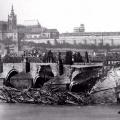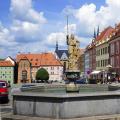Changes that occur to the objects around us are classified as chemical and physical phenomena. To learn to recognize the one and the other, you need to understand their very essence.
Definition
Phenomena that lead to the emergence of completely different substances from the original are called chemical ones. Examples: burning wood chips, obtaining kefir from milk, the formation of starch in plants.
Physical phenomena are called phenomena that do not affect the molecular structure of substances. Examples: modeling from plasticine, formation of frost, bursting of a ball.
Comparison
Thus, the decisive criterion is the depth of the changes taking place. The difference between chemical and physical phenomena is that in the first case, the initial substances are completely destroyed, and in the second they remain by themselves. In other words, chemical processes lead to more dramatic changes, because they occur at the molecular level.
Similar reactions can occur with direct contact of substances in the absence of additional factors, as well as under the influence of electricity, light waves, heating, or the participation of catalysts. The output is substances with a new composition and properties. For example, rust, into which a layer of iron sheet is transformed in the air under the influence of moisture, is a substance with completely different characteristics than iron itself.
Certain signs indicate that a chemical transformation has taken place. In one case, the taste changes (like cabbage after pickling), in the other, the color (the blue of the starch solution when a drop of iodine is added to it), in the third, gas is released (the interaction of soda and vinegar). Sediment, odor or heat generation may also occur.
What is the difference between chemical and physical phenomena? The fact that the latter, carried out without the destruction of molecules, entail changes of a different nature. For example, there is a transition to some other state of aggregation (hard chocolate melts in the palm). The shape (rolling out the dough), dimensions (reducing the length of the wires in frost), position in space (falling of the ball) can change. But chemical composition in all cases remains the same.
STATE BUDGET EDUCATIONAL INSTITUTION
SECONDARY EDUCATIONAL SCHOOL № 336
NEVSKY DISTRICT
What is the difference between physical
and chemical phenomena?
development of a lesson in nature studies
for grade 5
Educational technologies:
conversation, dialogue, technology of the activity method, developmental technologies,
information and communication technology
Developed by:
Samokhvalov Andrey Sergeevich ,
chemistry and biology teacher
GBOU Secondary School No. 336 of the Nevsky District
St. Petersburg
year 2013
Lesson topic : "What is the difference between physical and chemical phenomena"?
Lesson type : a lesson in learning new material
Lesson objectives :
1). Educational:
Compare physical and chemical phenomena and establish their essential difference: a). with a chemical phenomenon, some substances are converted into others; b). with physical phenomena - it does not happen.
2). Developing:
Develop the ability to observe, compare, draw conclusions, formulate definitions, reason, prove their judgments.
3). Educational:
Establish the relationship between physical and chemical phenomena, give an idea of a chemical reaction, show that interconvertibility chemical substances serves as proof of their material unity.
Equipment and reagents : laboratory equipment: a set of chemical glassware; reagents: starch solution, iodine solution, CuSO 4 solution, NaOH solution, HCl solution, a piece of chalk, matches, a rack with test tubes, multimedia equipment, Interactive board, presentation "Physical and chemical phenomena". Leaflets with a written test task.
Planned Outcomes (Students Should) :
a). know: determination of physical and chemical phenomena, signs and conditions of the course of chemical reactions, the importance of physical and chemical phenomena in human life;
b). be able to: distinguish between physical and chemical phenomena, apply knowledge of physical and chemical phenomena in practice.
Educational technologies : conversation, dialogue, technology of the activity method, developmental technologies, information and communication technologies.
During the classes :
I.Organizing time.
II. Checking the passed material (frontal survey).
|
Teacher actions |
Student actions |
|
Formulates questions, gives explanations to tasks. 1). What is Matter? 2). What is the physical body? Give examples of physical bodies. 3). What is substance? 4). Do the substances remain unchanged? 5). Indicate the main signs characteristic of the substance. 6). What are substances made of? 7). What are molecules? eight). What is the name of a particular kind of atom? nine). What groups can be divided into substances? ten). What is the difference between a simple substance and a complex, organic from inorganic? |
They answer the questions posed. |
III. Learning new material.
We know from past lessons that natural history is a natural and experimental science, which, like chemistry, studies, among other things, substances and their properties. There are always substances around us. But do substances always remain unchanged? Nature is a huge laboratory in which the state of aggregation, the form of various substances are constantly changing, and new substances are being formed. Rocks and minerals under the influence of the sun, water, carbon dioxide and other substances are gradually destroyed and converted into new substances. In green plants, glucose and starch are formed from carbon dioxide and water. A person transforms substances taken from nature (natural gas, oil, ores) into gasoline, rubber, plastics, fibers, metals he needs. Often, as a result of many transformations, new substances are obtained that do not exist in nature. With all these phenomena, the initial substances are destroyed and new substances are formed from their constituent parts.
Today in the lesson we will look at some of the phenomena and explain them.
|
Teacher actions |
Student actions |
|
Conversation, explanation of new material, accompanied by a presentation. Slide 1 (lesson topic) 1. Phenomena of nature. Phenomena. a). What happens to the bodies of nature in autumn? b). How can these events be called? Phenomena can occur not only with the bodies of nature, but also with artificial bodies: a candle burns, an electric lamp is lit, a ball bursts, iron rusts, a green coating forms on copper objects, and so on. Based on the foregoing, students formulate their own definition of the concept " phenomena "Then slide 2 compares the students' answers to the true answer. 2. Phenomena are physical and chemical. Demonstration of experience from slide 3. rice. and fig. b fig. v Question : "What processes are shown in figures a, b, c"? We discuss the experiments and come to the following conclusions : various changes took place with substances, which are called phenomena ; in fig. a and fig. b only the degree of grinding sugar changed, but the substance remained the same, its characteristic property (sweetness) not lost; in fig. turned into sugar into new substances - coal and water. |
Write down the topic of the lesson in a notebook. Estimated student short answers: a). leaves fall; the temperature drops; it is raining, snowing; the grass becomes covered with frost, turns yellow; Thunder; the river freezes and so on; b). natural phenomena or just phenomena. Students independently formulate the definition of the concept " phenomena ", then they compare this concept with the scientific definition from slide 2 and write this definition in their notebooks. Estimated student responses: 1). In fig. a shows the process of grinding a piece of sugar in a mortar. 2). In fig. b shows the process of dissolving crushed sugar in water. |
IV. Physical education, and then - the continuation of the study of new material.
Physical education :
"We will rest a little,
Let's get up, take a deep breath
Hands to the sides, forward.
Children walked in the woods,
Nature was watched.
They looked up at the sun
And the rays warmed them all.
Miracles in our world:
Children have become dwarfs.
And then everyone stood up together,
We have become giants.
Clap together, stamp our feet!
We took a good walk and were a little tired "!
|
Teacher actions |
Student actions |
||||||||||||||||||||||||||||||||||||||||||||||||||||||||||||
|
There are several types of physical phenomena (see slide 4): Demonstration of the experiment "Studying the properties of sulfur and iron" from slide 5 according to the plan: Teacher-class conversation (questions for students) . Do the properties of substances in the mixture change? Heat the resulting mixture of sulfur and iron in a test tube. What are you seeing? Let's extract from the test tube what was formed after the reaction and study its properties (color, relation to water and magnet). To do this, grind the resulting substance and act on it with a magnet. What are you seeing? Immerse the resulting substance in water. What are you seeing? What happened when sulfur and iron were heated? Chemical phenomena are also called chemical reactions ... Any chemical reaction is accompanied by changes, which are called signs of chemical reactions ... There are seven such features (see slide 6). Let's consider these signs using the example of specific chemical reactions. ( Remind safety rules). We carry out laboratory experiments and enter the results in the table ( work with laboratory experiments is carried out in groups, which involves discussion of the results between group members).
After students have experimented and completely filled out the chart in their exercise books, the teacher on the interactive whiteboard asks them to compare the chart on slide 8 with the correct answers.
Exercise . On the basis of the knowledge gained, it is necessary to find out: "What conditions need to be created in order for a chemical reaction to arise and can proceed"? Let's discuss this issue and formulate the necessary conditions. We will record the result in a notebook. V. Checking the assimilation of the studied material. Exercise . The students on the interactive whiteboard on slides 10 and 11 demonstrate the types of phenomena without names. Slide 10 Slide 11 Vi. Physical education, and then - consolidation of the studied material. Physical training : "All now we will stand together, Let's turn right, left, Let's bend over, let's stand upright Let's go back to class. " Consolidation of the studied material . Exercise . You (see slide 13) are given the following list of phenomena. Divide these phenomena into two groups (physical, chemical) and explain on what basis you did it ( there is a discussion of the issue, the result is entered in a notebook in the table shown on slide 14).
|
Students write down the classification of physical phenomena in notebooks, then give their examples with explanations. Students maintain a dialogue with the teacher (observe experiments, answer questions). No. The substances that make up the mixture retain their individual properties. The mixture began to darken and then glowed red. The powder is not attracted by the magnet. The substance sinks, it does not separate into sulfur and iron. When sulfur and iron were heated, a new substance was formed, which in its properties differs from the properties of the original substances. Students from slide 6 write in their notebooks the physical phenomena that accompany chemical reactions. Students orally answer the teacher's questions about safety rules when working in a chemistry room. Students from slide 7 trace the table in their notebooks and then independently, under the supervision of the teacher, begin to conduct experiments and enter their observations and conclusions in the table. Students compare the entries in their tables with the entries in the table from slide 8 and, if necessary, correct or correct their answers. Students verbally state their answers (assumptions), and then compare their statements (answers) with the answers on slide 9. Students, looking at slides 10 and 11, recognize the types of phenomena, explain why they decided so, formulate a definition of phenomena (physical, chemical), compare their formulated definitions with the definitions on slide 12 and make appropriate entries in their notebooks. Pupils complete the exercises from their desks into the aisles. Students work in groups, which involves discussion of the results between group members. The results are entered by students in a notebook, and then from slide 15 for the purpose of checking (correcting) the students check the correctness of the assignment. |
Vii. Lesson summary.
VIII. Homework.
LIST OF SOURCES USED
1. Pakulova V.M. , Ivanova N.V. Natural science. Nature. Unliving and alive grade 5, textbook, M .: Bustard, 2007.
2. Pakulova V.M. , Ivanova N.V. Natural science. Nature. Inanimate and alive. Grade 5, workbook... M .: Bustard, 2010.
3. Pakulova V.M. , Ivanova N.V. Natural science: Nature. Inanimate and alive: Grade 5. Thematic and lesson planning. M .: Bustard, 2010
4. Unified collection of digital educational resources http://school-collection.edu.ru/
5. Physical and chemical phenomena. Internet resource http://www.rudg.ru/
7. CD disk " Great encyclopedia Cyril and Methodius 2009 ”. - LLC “Cyril and Methodius, 2009.
8. CD-disk “General and inorganic chemistry”: Advanced course in general and inorganic chemistry. - Laboratory of multimedia systems, MarSTU, 2008.
APPLICATION
Test: "Physical and chemical phenomena"
Option I.
Set correspondence:
Physical phenomena: _______
Chemical phenomena: _______
- The water in the lake was covered with a crust of ice.
- The appearance of rust on the iron nail.
- The gold wire was pulled into a thread.
- Combustion of gasoline in an internal combustion engine (in a car).
- The ice toy melted in the spring.
- Drying rain puddles.
- To prepare the dough, baking soda and acetic acid were mixed in a spoon.
- Tide.
- A piece of lead was thrown into nitric acid, it "disappeared", "dissolved", while a brown gas was released.
- The ice was dropped, it broke, and there were several pieces of ice.
Option II.
Set correspondence:
Physical phenomena: _______
Chemical phenomena: _______
- Weathering of rocks.
- The silver spoon darkened in the air.
- Evaporation of water from the surface of the river.
- Burning kerosene in a lamp.
- Air movement (wind).
- Souring of milk with the formation of kefir.
- Melting a piece of iron.
- Burning a match.
- Children on the beach have built a castle out of sand.
- A piece of zinc was thrown into hydrochloric acid, and gas began to evolve intensively.
"Physical phenomena in everyday life" - Hoarfrost. Scientific explanation of what he saw. Cold. The blue is the color of the sky. Air. Physics. Optical phenomenon. The volume is increasing. Setting sun. Physics is the science of curious researchers. Rainbow. Powerful rain clouds. Nature. Thickness of the cloud formation. Sunset.
"Physical phenomena in nature" - Wrong! What does physics study? Can the incident be called a physical phenomenon? Thermal. Let's get there. Can the appearance of a wizard be considered a physical phenomenon? Magnetic phenomena. Optical phenomena... Sound. Let's light up the Steppe Dal with bonfires. Further. Name a physical phenomenon. A kind wizard appeared to you in a dream and treated you to ice cream.
"Examples of physical and chemical phenomena" - Separation funnel. How physical phenomena differ from chemical phenomena. Physical phenomena. Obtaining distilled water. The concepts of physical and chemical phenomena. Classification of reactions. Sublimation of iodine. Filtration. Conditions for the occurrence and course of reactions. Phenomena in which the state of aggregation changes.
"Phenomenon in physics" - An experiment is carried out to study a phenomenon. Observations and Experiments. Physics is one of the main sciences of nature. Physics. Much knowledge is gained by people from their own observations. Substance and matter. What physics studies. Physics around us. In physics, special words, or terms, denoting physical concepts are used.
"Physical phenomena" - What physical phenomena are used to obtain pure chemicals? Physical phenomena in chemistry. Oil distillation conditions: temperature 320-350 ° С. Studying a theoretical issue and conducting laboratory experiments. How to reconcile people who quarreled over spilled salt? Gasoline and water. What phenomena are called physical?
"Physical phenomena in literature" - The spread of odors. Give me a foothold. Static electricity. Pressure. Ebb and flow. Gravity. The phenomenon of inertia. The strength of Archimedes. Sound volume. The phenomenon of condensation. Specific heat. Fluctuations. Compass. Barometer. Potential energy. Electricity. Bad physics. People on the moon.
There are 11 presentations in total
I remember when I was in chemistry class at school, I first heard about chemical and physical phenomena... This information interested me very much, and I decided for myself to figure out what is the difference between these concepts. Perhaps it was this topic that influenced the fact that I began to study chemistry and entered the Faculty of Chemistry. Be that as it may, these phenomena have become for me one of the most great discoveries.
Physical phenomena
Physical phenomena are processes in which the original substance is not converted into another. This substance can change the state of aggregation, for example: turn from a liquid into a gas, or change shape, but her structural formula will remain the same... For example, water in a river may become ice during a cold snap or evaporate, but this is the same water. When forging metal, the workpiece is stretched, twisted, but this is also iron.
Chemical phenomena and their difference from physical
Chemical phenomena are processes in which the original substance turns into another... Thus fromthe structural formula of a substance, the number and variety of atoms of an element change. If you forget for a moment that alchemy is impossible, then a chemical phenomenon can be called alchemy, because one substance turns into another. An example of a chemical phenomenon would be combustion of any substance, because during combustion the compound is oxidized by oxygen... Wood or cellulose with the formula (C6H10O5) n burns, producing carbon dioxide (CO2) and water (H2O). Thus, our original substance is cellulose has changed its structural formula, which means it is a chemical phenomenon... Chemical phenomena are characterized by:
- The appearance of sediment.
- Color change.
- Gas evolution.
- Absorption or release of heat.
Thus, if you leave the knife in the rain, it will be covered rust and this is a chemical phenomenon, because pure iron (Fe) will turn into iron oxide (Fe 2 O 3). Our knife from a steel color will turn brown, and this is one of the signs of a chemical phenomenon.
Without chemical phenomena, our Universe would not exist, because itself Zthe earth was formed as a result of billions of complex reactions... AND hundreds of chemical phenomena occur in our body every second, whether it is breaking down fats, or digesting food.




